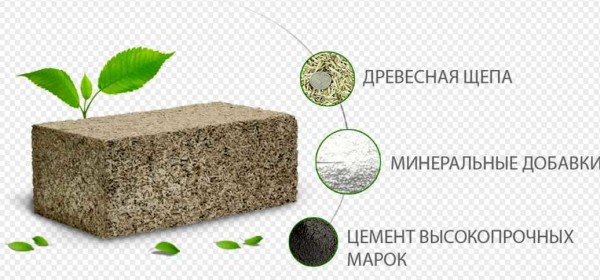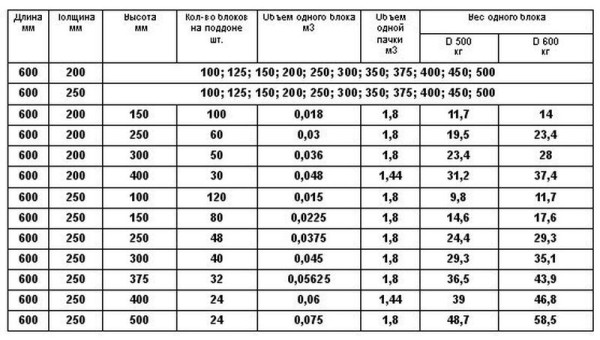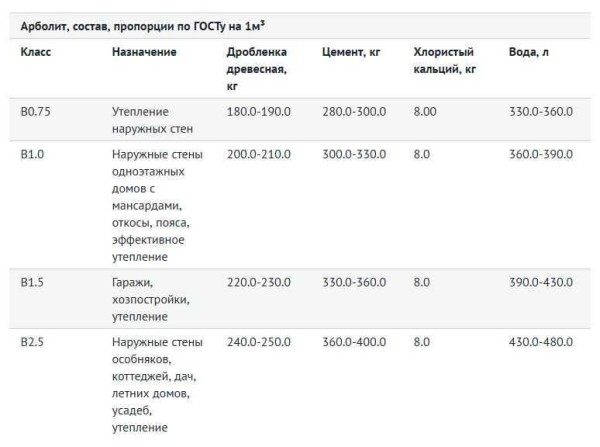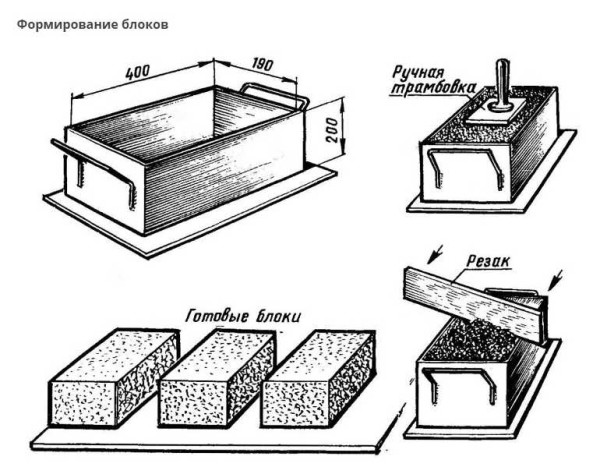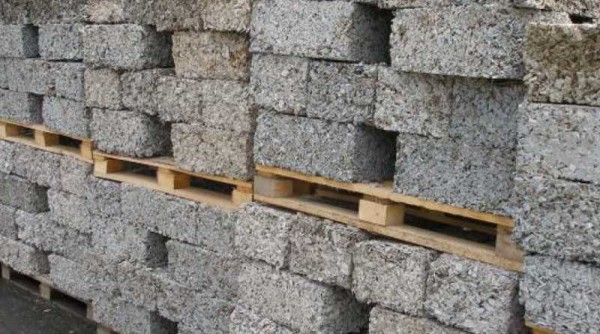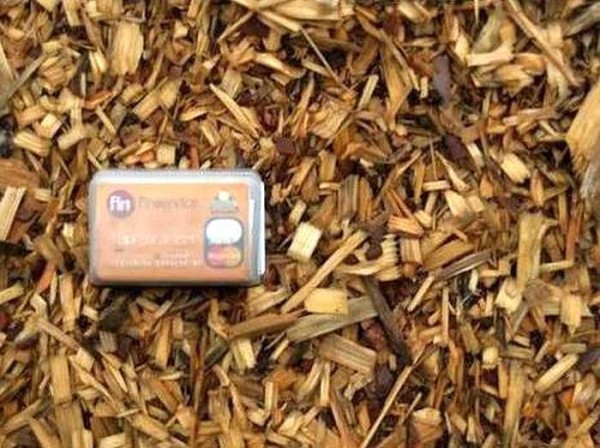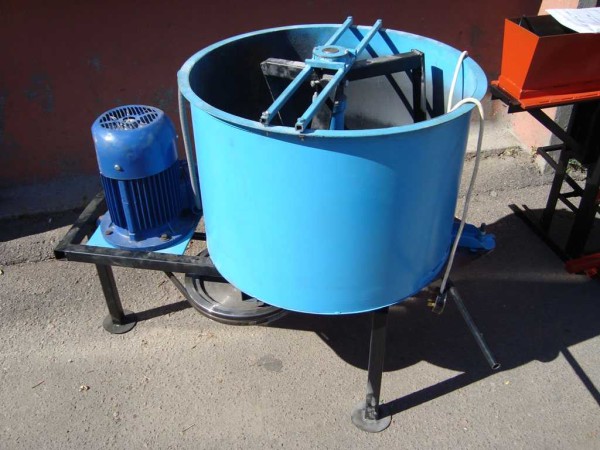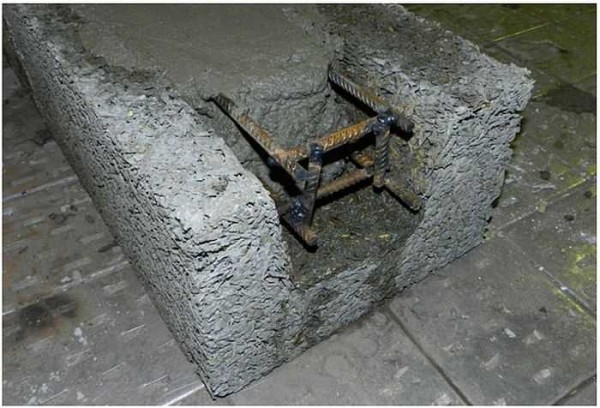DIY wood concrete blocks
Arbolit, as a building material, was known back in the days of the USSR, factories worked, and houses were built. After the collapse of the country, the technology was forgotten for some time, and a few years ago it was remembered again. The material turns out to be warm, lightweight, durable, poorly conducts sounds, and its cost is also low. Therefore, wood concrete and wood concrete blocks (wood blocks) are increasingly of interest to private developers.
Let's immediately determine that wood concrete and sawdust concrete are different materials with different characteristics. The wood concrete contains waste from the woodworking industry, but only of a strictly regulated size. There is no other placeholder anymore. And everything is spelled out in GOSTs and instructions. And the filler is not sawdust, but wood chips with sizes recommended by the standard not exceeding 40 * 10 * 5 mm.
The content of the article
Properties, advantages and disadvantages
For a private developer, when choosing a building material, the technical characteristics of the material are important. Let's consider wood concrete blocks from this side. So, the characteristics and their short decoding:
- Thermal conductivity - 0.08 - 0.14 W / m ° C (depending on the density, the higher the density, the higher the thermal conductivity). The characteristics are comparable to those of wood. She has this indicator of 0.14 W / m ° C, for ceramic bricks 0.6-0.95 W / m ° C. That is, the doi from wood concrete blocks will be warm, and the width of the walls is small. For central Russia, it is recommended to make walls 30-40 cm thick in houses of permanent residence.
- Frost resistance - 25-50 cycles. This parameter means that walls can freeze / freeze from 25 to 50 times without prejudice to their qualities (depending on the manufacturer). If the house is a permanent residence, then it will not freeze at all. For unheated summer cottages, the service life of 25-50 years is quite acceptable.
- Compressive strength - 0.5-5 MPa. This is one of the most attractive features of wood concrete - it is difficult to destroy it. Another point: it regains its shape after removing the load. That is, by hitting with a sledgehammer, you can make a dent, but after a while it will even out - partially or completely depends on the "severity" of the damage.
- Flexural strength 0.7-1 MPa. This means that when some distortions appear in the structure (the foundation has sat down unevenly), the wood concrete blocks will not burst, they compensate for a rather large load.
The properties are very good. Another thing is that they will only be subject to exact observance of proportions and technology. This is why arblite blocks are dangerous: you don't know how well they are made.
Performance characteristics
As you can see, the characteristics of the arboblock are not bad. To the pluses, you still need to add light weight, large size and good ability to absorb sounds. A very big plus - the blocks are easy to cut, it is easy to give them the desired shape. Another positive point is that nails and screws hold well in the arbolite. On this side, too, no problems.
- Shrinkage - 0.5-0.6%. This parameter shows how much the geometric dimensions of the wall will change under load. Arbolite has one of the lowest rates.
- Water absorption 40-85%. This figure is very large. If you put a wood concrete block in water, it can absorb a lot of water.For the developer, this means that it is necessary to take care of a good shut-off waterproofing between the foundation and the first row of blocks. Also, an arbolite house needs an exterior finish that will protect the material from moisture. Not so scary. It is much more important that the hygroscopicity of wood concrete is low (the ability to accumulate vaporous moisture). Even in very humid air, it does not get damp, but passes vapors through itself, regulating the humidity in the room.
- Fire resistance - class G1. Arbolite refers to materials that do not support combustion. This is their undoubted plus.
If we talk about technical characteristics, then there is essentially one serious minus - high water absorption. There is one more drawback, but it is from the field of operation. Arbolite is very fond of mice. The material is natural and warm. You can solve the problem by making a high base - at least 50 cm.
Arbolite blocks production technology
Arbolit refers to lightweight concrete, the technology is almost standard, with the exception of some nuances: the need for pressing and using not an ordinary gravity concrete mixer during mixing, but a forced one. It mixes chips better with the rest of the components.
Structure
The wood concrete contains four components:
- high quality cement (M 400 or M 500);
- wood chips;
- water;
- chemical additives.
The cement must be dry and fresh. Wood chips are of a certain size. The fewer the re-grading, the stronger the block will be. Chemical additives are calcium nitrate and chloride (food additive E509), water glass, aluminum sulphate and some other substances. Please note that they are first diluted in water and only then added to the chips, mixed. Any drinking water is allowed, but not technical, without contamination. After the chips are evenly wet, add cement. Another sequence is not valid.
Types and sizes of blocks
Depending on the density, wood concrete blocks are divided into heat-insulating blocks (up to 500 kg / m3) and structural (from 500 kg / m3 up to 850 kg / m3). For the construction of one-story houses, you can use the lightest of the constructional density of 500 kg / m3... For detached houses of 1.5 and 2 floors, the minimum density is 600 kg / m3 and higher.
The sizes of wood concrete blocks can be different. The most common - 500 * 200 mm and different thicknesses - from 100 mm to 400-500 mm. But different factories and workshops produce blocks of different sizes. Molds for them can be welded from ordinary sheet metal, so this is not a problem. The photo shows an example of the assortment of one of the shops.
As you can see, blocks of 600 * 200 mm and 600 * 250 mm also have a thickness from 100 to 500 mm. You can choose suitable for both load-bearing walls and interior partitions. Also, for self-production of wood concrete blocks, it will be possible to make a suitable shape. This is if you decide to do them yourself.
Proportions
Like any building material, wood concrete is divided by strength classes. For the construction of load-bearing walls of houses, the required strength class B 2.5.
The amount of materials required per cubic meter of wood concrete solution is in the table (photo above).
Pressing technology
All these components are mixed, from which blocks are formed. There are several technologies:
- just by pressing:
- manual on the floor (great effort required);
- manual ramming on a vibrating table.
- pressing with vibration on a vibrating machine.
The easiest way is manual pressing. But it is difficult to control the density and strength of the resulting blocks in this way.
Normal production conditions
For the normal process of cement hydration, a temperature of at least + 12 ° C is required. There are no other conditions. The peculiarity of the production is that after the block is formed, at least 2-3 weeks must pass before the start of its use.During this time, the cement will gain about 50-60% strength (depending on the temperature) and you can already work with the blocks. That is, the blocks must be made long before the start of construction. Considering that the chips must be aged for at least 4 months before using them, then you can start a year before construction.
Another practical point: if you are going to make wood concrete blocks with your own hands, in addition to a platform for kneading and storing components, you need a platform for settling the blocks. The place should be covered, protected from rain and sun. There should be no drafts.
Wood concrete chips: how to get or where to buy
The best wood chips for wood concrete are obtained from pine and spruce. You can also use larch, but when mixing, you need to double the amount of chemical additives. From hardwoods GOST allows the use of aspen, beech, birch, poplar. The main requirements are:
- The maximum dimensions are 40 * 10 * 5 mm. The optimal parameters of chips have been experimentally established - about 25 mm long, 5-10 mm wide, 3-5 mm thick. The most durable wood concrete blocks are obtained from such raw materials.
- The amount of bark should not exceed 10%.
- There should be no dust, sand, soil, impurities. The chips are removed from small fractions, dust and sand with the help of a sieve, and large foreign inclusions are removed manually (often these are pieces of soil or stones).
- There should be no visible mold and rot.
The best wood chips are obtained from lumpy wood waste. It is first passed through chippers and then crushed in a hammer mill. The following mechanisms can be used for this:
- Disc chippers with adjustable knives. Not all of them can be adjusted to obtain the required chip size, but the dimensions will be close.
- Rotary knife crushers. Narrow and narrow chips come out of them, and the length is adjustable. So this is a good option. There is only one "but": there are many knives and with prolonged use they need to be changed or welded (they do not sharpen). On the plus side, we add that crushers of this type can be used to re-crush the process chips obtained during the first crushing (after reconfiguration).
- Shredders or roller shredders. This expensive equipment (about 1 million rubles), and mostly imported, but it is excellent, as it is made for certain sizes of chips.
If you make wood chips yourself - not an option, you can buy it. If possible, you can agree at the plant where wood concrete is produced. Only check the parameters of the chips. If there is none nearby, you can take shavings from under the sizing machines. Some of them can be adjusted so that the chips are not thick.
Features of the manufacture of mortar for wood concrete blocks
Wood waste contains sugars. If fresh raw materials are used, the sugars can begin to ferment, which will destroy the integrity of the block. When kneading, chemical additives are added to the solution that neutralize their effect (water glass, calcium chloride, alumina sulfate, lime). They can be added in combinations: calcium chloride with water glass or sulphate alumina with lime. The total weight of the additives should not exceed 8%.
There are other ways to break down sugars. The simplest, but requiring a long period of time, is to keep the chips for at least 90 days in a heap in the air. If there is no way to wait, the chips are soaked for 3 days in lime milk, stirring occasionally. Then they strain it off, do not dry it, in this form it is used for kneading. Only in this case it is necessary to take into account that much less water is required. This method works well, but it's very troublesome. It is easier to find an opportunity to purchase chemical additives.
The procedure and features of mixing the solution
For mixing the solution, a forced-type concrete mixer is used.You can also use an ordinary gravitational or "pear", but you have to knead in it for a long time, although you can adapt - tilt the pear as low as possible during kneading (when raised, it hardly mixes).
First, sawdust is poured, some water is added. While the sawdust is getting wet, chemical additives are diluted in a small amount of water, then they are unloaded into a concrete mixer. When all the wood is evenly wet, cement is poured. It is loaded in portions, waiting for uniform distribution throughout the volume. The cement should wrap around every chip on all sides. This is possible only if the sawdust is well wet, therefore we carefully monitor this stage.
Block molding
The solution is spread into molds. Most often they are made of metal, they represent a box with handles without a bottom. The form is placed on a flat surface (a board, for example). When manually ramming, the molds are filled with wood concrete solution, layer by layer, each of which is pressed with a metal platform with a handle. In order for the air to escape better, the thickness of the material is pierced several times with a metal rod, after which it is pressed again. This procedure can be repeated several times, until you reach the desired layer density, after which you can fill in the next one. Layers are poured up to the upper edge of the block, after the final ramming, the top is leveled, cutting off the excess with a metal bar.
You can use a lever - mechanical or with a drive. In this case, the effort develops significant and the entire volume can be loaded at once, if necessary, supplementing to the edge. To achieve a high density, you can press several times, then increasing, then weakening the pressure. Experience shows that with this principle of manufacturing wood concrete blocks, they are more durable, unpressing (restoration of the shape due to the elastic force of the chips) manifests itself much less.
Blocks of better strength and with less effort are obtained if vibration is added to the pressing process. In this case, the efforts required to obtain the required strength are reduced significantly. For these purposes, vibrating tables are made. And the process is called vibration with a load.
The formed block on a stand is transferred to the drying place. If the solution allows and the block keeps its shape, the frame can be removed. But sometimes homemade wood concrete blocks sin by the fact that the solution turns out to be too liquid - it's easier to ram this way. In this case, the blocks are left in the mold for a day. Use and transportation of blocks is possible not earlier than 2-3 weeks after molding.
Features of the construction of their wood concrete blocks
The blocks are laid according to the brick type - with bandaging of the seams, on a cement-sand mortar. Of the features - the seam thickness is about 8-10 mm. Between the foundation and the first row of blocks, a very high-quality shut-off waterproofing must be done. This is to exclude the suction of moisture through the foundation from the soil. We make combined waterproofing - first we impregnate with bitumen mastic or any other coating waterproofing, on top we lay roll waterproofing. Previously, roofing material was always used, but today it is of poor quality and will collapse in a couple of years. And it is important to exclude moisture leakage (due to the high water absorption of wood concrete), therefore use a waterproofing or something similar. It is possible, in two layers, also smeared with bituminous mastic.
The next nuance is the masonry over the window and door openings. It is best to use special U-shaped blocks in which to lay the reinforcing frame and 4 reinforcement bars with a diameter of 10-12 mm. It is better to tie it so that there is less chance of corrosion. First, blocks with grooves are installed above the opening. They can be propped up from below with a board and spacers. Then the frame is laid, everything is poured with concrete. Leave the structure for a day, after which the props can be removed and continue laying.
There are many nuances of building a house from wood concrete blocks in the video.



